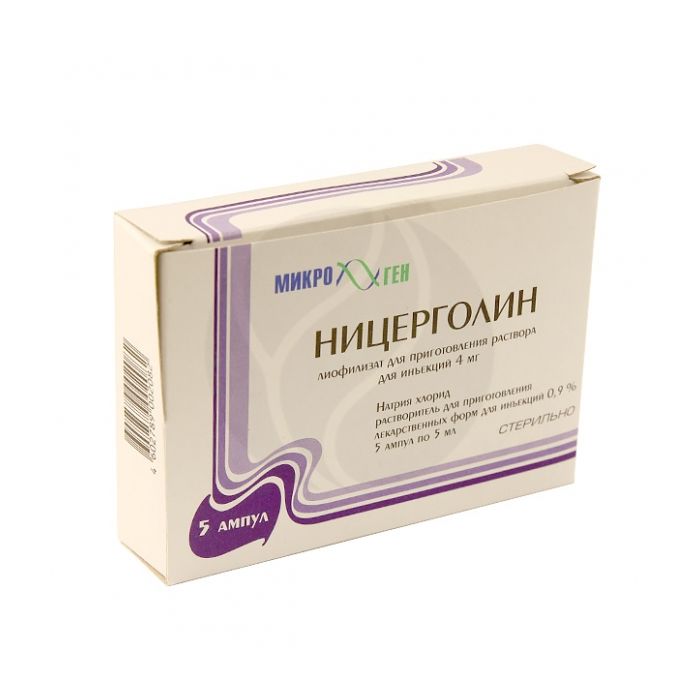Nicergoline lyophilisate for injection 4mg, No. 5 with solvent
Expiration Date: 05/2027
Russian Pharmacy name:
Ницерголин лиофилизат для инъекций 4мг, №5 с растворителем
cerebral circulation disorders (atherosclerosis of cerebral vessels, thrombosis and thromboembolism of cerebral arteries, cerebral ischemia, post-traumatic encephalopathy, psychoorganic syndrome);
vertigo;
migraine;
vascular disorders of the peripheral circulatory system (organic and functional);
limb arteriopathy;
obliterating endarteritis;
Raynaud's disease;
diabetic angiopathy;
degenerative diseases of the cornea;
diabetic retinopathy;
ischemic neuropathy of the optic nerve.
V / m, i / v and intra-arterially, after dissolving in the attached solution of sodium chloride 0.9%, i / m - 2-4 mg 2 times / day.
Intravenous drip - 4-8 mg per 100 ml of saline sodium chloride solution (if necessary, the administration can be repeated several times a day).
Intra-arterial - 4 mg in 10 ml of saline sodium chloride solution for 2 minutes.
The healing effect develops gradually. The course of treatment is at least 2 months.
Lyophilisate for preparation of solution for injection in the form of a porous mass or powder of white color, odorless.
1 amp.
Active substance:
nicergoline - 4 mg
Excipients : tartaric acid - 1.04 mg, lactose monohydrate (milk sugar) - 30 mg.
Solvent: sodium chloride solution 0.9% (5 ml).
arterial hypotension;
severe atherosclerosis of peripheral vessels;
exertional angina;
organic heart damage;
myocardial infarction;
pregnancy;
lactation period;
hypersensitivity to nicergoline.
Clinical and pharmacological group: Alpha1-blocker
Pharmaco-therapeutic group: Alpha-blocker
pharmachologic effect
Alpha-adrenergic blocking agent is a synthetic derivative of ergot alkaloids, with an attached bromine-substituted nicotinic acid residue. Has a vasodilating (including in relation to cerebral arteries) effect. Improves microcirculation. The contained nicotinic acid residue has a direct myotropic antispasmodic effect on the muscular membrane of resistive vessels, increases their permeability to glucose, which is most clearly manifested in relation to the vessels of the brain and extremities. Improves cerebral, pulmonary and renal blood flow. Reduces vascular resistance of the central vessels, increases arterial blood flow, increases the delivery of oxygen and glucose. Improves blood supply to the extremities, especially in case of circulatory failure due to functional arteriopathies. In therapeutic doses, it does not affect blood pressure,in patients with arterial hypertension, it can cause a gradual moderate decrease in blood pressure.
Pharmacokinetics
Absorption is high. Bioavailability is about 60%. Tmax -2-4 hours Undergoes biotransformation in the liver with the formation of inactive metabolites. It is excreted mainly in the feces.
Indications
cerebral circulation disorders (atherosclerosis of cerebral vessels, thrombosis and thromboembolism of cerebral arteries, cerebral ischemia, post-traumatic encephalopathy, psychoorganic syndrome);
vertigo;
migraine;
vascular disorders of the peripheral circulatory system (organic and functional);
limb arteriopathy;
obliterating endarteritis;
Raynaud's disease;
diabetic angiopathy;
degenerative diseases of the cornea;
diabetic retinopathy;
ischemic neuropathy of the optic nerve.
Dosage regimen
V / m, i / v and intra-arterially, after dissolving in the attached solution of sodium chloride 0.9%, i / m - 2-4 mg 2 times / day.
Intravenous drip - 4-8 mg per 100 ml of saline sodium chloride solution (if necessary, the administration can be repeated several times a day).
Intra-arterial - 4 mg in 10 ml of saline sodium chloride solution for 2 minutes.
The healing effect develops gradually. The course of treatment is at least 2 months.
Side effect
Dyspepsia (nausea, vomiting, diarrhea, abdominal pain); hyperemia of the skin of the face and upper half of the body, a feeling of heat, sleep disturbances, decreased blood pressure, headache, dizziness, angina pectoris, symptoms of ergotism (cold extremities, pain in the extremities); itchy skin, allergic reactions.
Contraindications for use
arterial hypotension;
severe atherosclerosis of peripheral vessels;
exertional angina;
organic heart damage;
myocardial infarction;
pregnancy;
lactation period;
hypersensitivity to nicergoline.
Application during pregnancy and lactation
Contraindicated during pregnancy and lactation.
special instructions
After intravenous administration to prevent orthostatic hypotension, the patient must be in a horizontal position for 10-15 minutes.
Care should be taken when working with mechanisms. Drinking alcohol during treatment is not recommended.
Overdose
Not described.
Drug interactions
Nicergoline enhances the effects of antihypertensive, anxiolytic and antipsychotic drugs.
Antacids and cholestyramine slow down the absorption of nicergoline.
Storage conditions
List B. Keep out of the reach of children, protected from light at a temperature not exceeding 10 ? C.
Shelf life
Shelf life is 3 years.
Terms of sale
The drug is available with a prescription.

